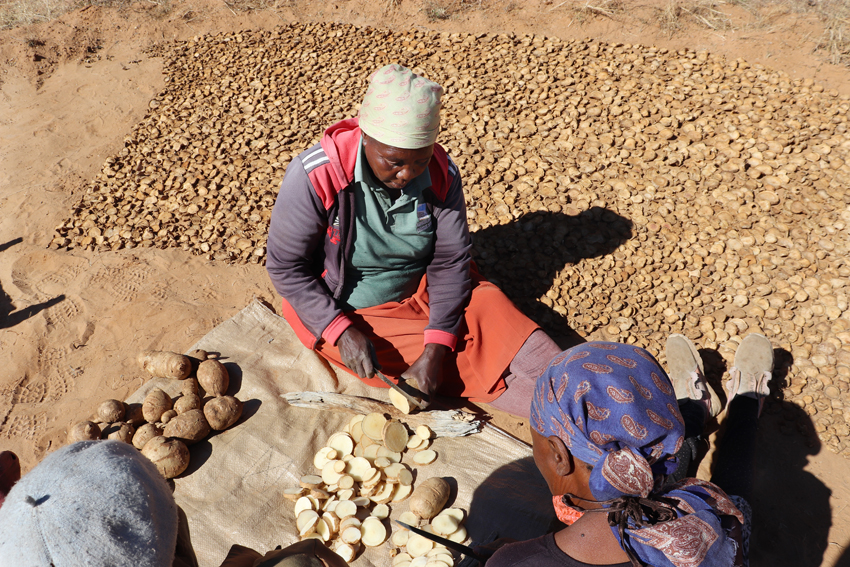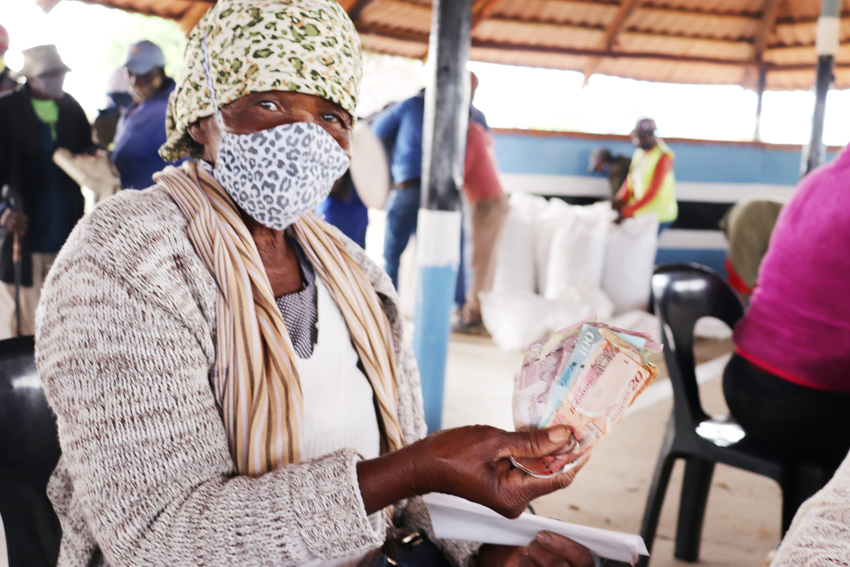Sengaparile seasonal bussiness for Kgalagadi
16 Nov 2020
Akin to any traditional African market, sale of devil’s claw known as sengaparile attracts hundreds of harvesters annually.
In Kgalagadi, the marketplace is a potpourri of cultural experience where one gets to mingle with the indigenous people, both the young and the old.
Usually conducted in designated Kgotla shelters, the market is a beehive of activity as donkey carts, old motor vehicles pull over to offload tonnes of bags of dried golden chips of sengaparile.
In some instances where there is no transport, harvesters walk barefooted bearing the weight of sengaparile on their shoulders to come and sell their harvest.
On this particular day in Kokotsha, the Department of Forestry and Range Resources government officials and the primary buyer, Mr Gerrit Struyf from Matebeleng Milling Company found most of the harvesters already in long queues from across the road to the Kgotla before sunrise true to the African adage, ‘an earliest bird catches the fattest worm’.
On yet another sale day in Makopong, the harvesters managed to come in large numbers.
They are well aware that the sale of sengaparile is not done in the comfort of an air-conditioned shop nor warm bonfire hence they have to make hay while the sun shines no matter the circumstances,
Earlier in May this year, many took it to the bush circumventing tough challenges to harvest sengaparile.
Some had to leave their school going children with relatives to go and harvest the potato like starchy and bitter tuber, which is usually oblong or rounded thickening or outgrowth of a subterranean stem.
“It was not an easy road to get to where we are now. It has been a long journey.
We had to dig every day in search of sengaparile. Sometimes when digging we found snakes and scorpions hidden under the ground.
It is a tough job,” says 37-year-old Kesegofetse Kudume whose bags weighed heavily on the scale.
She is elated with the increased sengaparile buying price of P28 per kilogram this year.
Her harvest makes 183 kg which instantly earns her P5 124.
To her, harvesting sengaparile is part of her culture and tradition. She learnt the ropes from her parents whilst she was still young.
She said harvesting sengaparile especially during winter season where the greenery was no more and one had to identify it in the middle of other dried plants required skill and someone who does not have a trained eye would miss it.
Ms Kudume narrated that while she was young, on school holidays she used to accompany her parents to sengaparile harvesting in the bush.
This had been a source of livelihood in the family for decades and they know that every year they had to harvest sengaparile.
However, she said the money they got from it comes once a year and therefore they sought piece work from Ipelegeng programme. They had been using the money to buy food, pay school fees and buy uniform for their children. But this year she plans to use the money differently to create a sustainable source of income such as starting a small tuck-shop.
She said that harvesting sengaparile required dedication, hard work and strategising as she had to set targets per each harvesting day.
For instance I would target to gather a 12.5 kg bag per day per and this had enabled me to make more money because last year I made around P2 500.
She said she planned to do produce more next year as she was satisfied with the buying price.
Meanwhile, Mr Gerrit Struyf of Matebeleng Milling Company said his company spent over P90 000 buying dried sengaparile in Kokotsha where the highest paid harvester walked away with P7 400.
“We are trying to pay the best price that we can. In 2015 we were paying P15 per kg we have been increasing the price over the years and this year we are paying P28 per kg,” he said.
He started his business in 2014 and they have been supplying local Chemists.
The business has grown in leaps and bounds and four years ago they secured international market where they export sengaparile directly to Europe.
“We sell locally but our local sales are about 2 000 kg per annum. It is a very small proportion because 90 per cent of what we buy we export directly to Europe,” he said.
There is high demand for sengaparile in Europe especially in the demography of old people.
“The key active ingredient in Sengaparile is harpogocide which cures rheumatoid arthritis, it cleanses the system.
This is something that had been used by indigenous people for centuries to cure pain,” he said.
Department of Forestry and Range Resources Kgalagadi District Coordinator, Naledi Batsima said government facilitated the sale of sengaparile and ensured that sustainable environmental practices were followed in the process.
This year, harvesters in Kgalagadi North and South had surpassed expectations by harvesting 14. 5 tons of Sengaparile against the estimated target of 9 tons per annum.
This, she said was attributed to the good rains last year which enabled the district to have it in abundance.
This year a total of 277 harvesters sold sengaparile which amounted to approximately P413 000. The villagers produced a total of 14 430 kg where majority of the harvest came from Kokotsha and Inalegolo.
In Tsabong Sub-district, 10 villages participated in the harvest such as Kokotsha, Makopong, Maleshe, MaCathy’s Rust, Draaihoek, Omaweneno, Bray and Werda and Gakhibane, Khawa which were participating for the first time this year.
In Hukuntsi Sub district harvesters were mainly from Inalegolo and Phuduhudu and Kang.
She said harvesters bought a harvesting permit for P2 which allowed them to harvest only and then they were required to buy a dealers permit which costs P50 to enable them to sell their harvest. However, she says government is in the process of reviewing the fees.
On ensuring sustainable natural resources and observing climate change protocols she said harvesters were encouraged to cover the dug holes where they harvested sengaparile and replant the tap root so that when rainy seasons come they were able to grow again.
She encouraged them to harvest at different areas on a rotational basis to enable the environment to replenish itself.
Meanwhile, she noted that plans were underway facilitate value addition to sengaparile given its proven health benefits and to create sustainable employment opportunities.
Furthermore, she said government facilitated the trading process where those who want to buy from harvesters showed expression of interest and consulted the community.
This year there were three bidders but the harvesters agreed to sell to the one with the highest buying price. Ends
Source : BOPA
Author : Calviniah Kgautlhe
Location : KOKOTSHA/MAKOPONG
Event : Interview
Date : 16 Nov 2020







